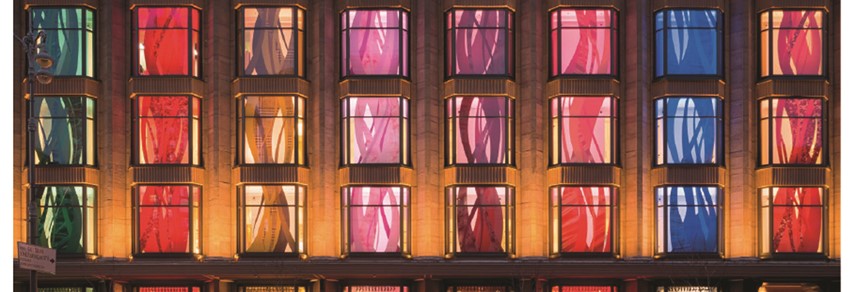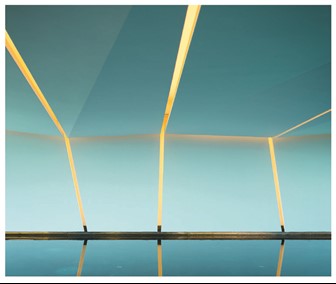
FROM THE ANNALS OF ARCHITECTURE
Boasting an impressive portfolio of brands, architectural firm Benoy is midway through celebrating its 71st year. How has the company transformed its previously inflexbile brand architecture to one befitting its global portfolio? Brittany Golob reports
Birmingham’s Bullring shopping centre, Heathrow’s terminal 4, Dubai’s City Walk area, Abu Dhabi’s Ferrari World, Singapore’s ION Orchard shopping centre, Guangzhou’s Parc Central and a number of Nottinghamshire barns have one thing in common. They were all designed by international architecture firm Benoy.
A homegrown UK brand with offices in 10 cities around the world, Benoy has grown its business over the past 70 years on the strength of its work, its people and its brand. But, after 70 years, the brand had become unwieldy and unrepresentative of the modern, global business. It also was too inflexible embrace the business changes made in Benoy’s group structure.
To increase the brand’s ability to adapt to change, it adopted a stone carved title stone as a means of uniting the business. The well-known Benoy brand had given way to the Benoy Group brand – the holding company which owns it – but, when the company acquired design business Holmes Wood, questions arose about the structure. Holmes Wood, an 18-year-old design consultancy working in the built environment, would also be situated in Benoy’s London offices in Monkwell Square. It was important for Holmes Wood to maintain its autonomy and unique brand positioning.
“It was very difficult to say, ‘We’re not owned by Benoy, we work alongside Benoy,’ when they
are owned by a company called Benoy Global. That’s where the creation of what we now have as Handley House came about,” says Laura Barnes, global brand director at Benoy. To develop a new brand for the holding company, Barnes looked into Benoy’s history. Founded in Nottinghamshire, the business is still headquartered in a Regency house in Newark-on-Trent. On the driveway approaching the house is a title stone proclaiming the building’s name as ‘Handley House.’
It was a serendipitous find for an architecture firm and a fitting name for an organisation that has built its business based on the built environment. It also effectively separated the brands, allowing Holmes Wood and Benoy a degree of autonomy.
Holmes Wood then began designing the visual identity for Handley House, choosing a subdued colour palette inspired by world-renowned architect Le Corbusier. The logo is both a pair of Hs sitting side by side and a representation of a floorplan. Holmes Wood toggled the crossbars of the Hs to elicit a more abstract logo than simply the letterforms themselves. Holmes Wood itself did not undergo a rebrand, but did reposition itself slightly to reflect its position as a sister company to Benoy.
But the real work was on the decades old Benoy brand. With a massive expansion of business in regards to both geographical area and to quantity of projects, the Benoy brand had grown bloated over the years. Barnes says it became difficult to maintain consistency across the nine markets the firm serves while also tailoring content locally. “It’s fair to say when creating Handley House and with the redesign of Benoy, it was about a growing-up of the brand,” Barnes says.
But grown-up didn’t mean staid. The crossbars on the Handley House Hs are just one of the quirky elements to the new brands that reflect the company’s personality. Another aspect was the notion of Handley House as a family. “We have our own title stone based on the title stone at Handley House and it’s a way of uniting the businesses together as one,” Barnes says, adding that each of the 10 global offices received its own title stone on 31 January, when the brand launched. But alongside that notion of family came the introduction of a ‘family tea.’ “What do people do when they come together? They drink tea,” adds Barnes. Because of tea’s intrinsic ties to Britain and Asia, it seemed fitting for a brand operating in the UK. The packets are branded in a Handley House grey and are available in each of the company’s meeting rooms.
The presence of Handley House-branded items in the meeting rooms allowed for the spaces that were once solely Benoy’s and now shared by Benoy and Holmes Wood to be neutralised. Pencils, for example, don’t say ‘Benoy’ or ‘Holmes Wood,’ but bear the initials ‘B’ or ‘HW’ or ‘HH.’ Notebooks and other stationery is similarly unbranded, but bear quirky puns in a subdued colour palette.
For the Benoy brand, though, a significant change was required. The brand has been fairly static for decades and the colour palette had a lot of bright colours and different types of photography. There was no consistent visual identity representing the persona of Benoy. As part of the groundwork for the rebrand, the company underwent an organisation-wide employer brand management change programme.
The employer brand team introduced the concept of ‘fire starters.’ These individuals would be brand ambassadors operating throughout the business who could help support the organisational change among their colleagues. The enthusiasm and success driven by this programme put Benoy into a prime position for examining its external brand, shortly after it renovated its internal one.
Through that process, the organisation determined Benoy’s personality and character. It then found that visually, the Benoy brand did not match up. One of the challenges was related to consistency. The global offices did not have an aligned experience, making for a disjointed experience for customers and employees working across the business. “We work with the same clients in lots of different territories, so it’s important that their experience of Benoy is the same regardless of where they are and what the touchpoint is. We had lost that,” says Barnes.
Once Holmes Wood stripped the colour palette back to the barest essentials, it focused on a monochrome visual identity accented by vivid colours in photographs of Benoy’s work. The black and white approach, though, could have been a challenging one. “Black can have a very negative connotation in Asian markets,” Barnes says. “Having said that, black and white work very well together in terms of the yin and yang.” By combining that with the colour inherent in Benoy’s work, a new palette was crafted.
The Benoy logo is a simple all-caps, sans serif wordmark in white on black. The web and print assets all take a similar approach, but with the addition of bright, lifestyle imagery documenting some of Benoy’s most interesting projects. The photography style was designed to not be typical architectural imagery, but to bring to life Benoy’s design work. For that reason, most of the photos feature people authentically interacting with the spaces. “It enables us to re-present our portfolio of projects and our capabilities in a far more consistent way,” says Barnes. The shift allows Benoy to position itself not only as an architecture firm but as a company with creative insights into masterplanning, interiors, architecture or design.
“We work with the same clients in different territories, so it’s important that their experience of Benoy is the same regardless of where they are and what the touchpoint is. We had lost that” |
 |
A new addition on the website was introduced in the midst of a cull of old online material. The bloated website featured every project, big and small, representative and not. To bring the site more in line with the new ethos, and to allow it to better reflect Benoy’s character, the team introduced the ‘On the drawing board’ section. This portion of the website features hand-drawn, black and white sketches of works in progress. The sketches are accompanied by short blurbs describing the project. Visually, they harken back to an architectural era when sketches were king. Now replaced by CAD renderings and 3D models, Benoy’s architects often still use pen and paper to sketch. Using those images as part of the works in progress portion of the site not only sits nicely with the monochrome colour palette, but engages the user’s imagination in a way computer renderings cannot.
That’s not to say the visual identity is old fashioned. One of the key features introduced in the rebrand was a graphic animation of the Benoy logo that was done in-house. The moving image can spell out any word in unique, 3D-like letterforms. Additionally, moving screen savers and short project reels were introduced to allow architects to better describe Benoy’s work to potential clients and employees.
“The new brand has given us an opportunity to reconnect with clients, to present them something different, to say, ‘Look how we’ve changed. You might want to have a conversation with us.’ A lot of the great work that we’re now bringing through on the website and through things like standardised credentials across the business that are in both Chinese and in English mean we can better showcase our work,” Barnes says. This has helped unite the organisation across its nine regions and unite its clients by allowing them to engage with work coming from all regions of the globe.
In addition to the new brand architecture, the website’s updating and a refreshed visual identity, the Benoy brand was also relaunched internally. Benoy worked with copywriting agency Stratton Craig to examine the brand’s tone of voice. The resulting strategy is authentic and straightforward, which Barnes says reflects the nature of Benoy. The new tone of voice avoids an overload of architectural jargon and keeps things simple to ease translation into Chinese. The rewrite has resulted in the reintroduction of marketing materials, product sheets, CVs, business documents and the like, which have been taken up enthusiastically by employees. The brand’s fire starters helped spur this shift and encourage people to look to the intranet for refreshed documents and presentation materials. Barnes says, “I did not want to be the brand police. I am the only person in this organisation who has brand in their job title, but I firmly believe that the brand is owned by every single member of this company and you have to be proud of it and understand it and protect it and maximise it in every way.”
But the new tone of voice will also be a benefit to Benoy as a recruiter. Benoy’s streamlined and consistent web presence, tone of voice and visual identity build a more persuasive picture for potential employees.
The brand officially launched on 31 January, on which day the old website was turned off, the title stones unveiled around the world and all of Benoy’s social media channels were updated. Other things are being rolled out over the next months, including a limited raft of new printed material, digital tools for employees and other assets. But the biggest shift has been in behaviour. Though Barnes says it has not been easy to get Benoy’s employees – some of whom have been with the company for 20 or more years – to change the way they approach branded material, they are indeed changing.
With works in progress ranging from the Bahrain Marina to a contemporary apartment complex in Hanoi to a major mixed-use development in Montreal to an eye-catching skyscraper in Delhi to a Westfield shopping complex in Milan, Benoy’s work is vast, varied and focused globally on commercial impact, architectural efficacy and practical, beautiful design. Now, for the first time in 70 years, its brand reflects those same values and that same character.
Peer review
Clive Rohald, partner, Prophet

When I first saw the Handley House identity I had to take a second glance. The resemblance to Soho House was uncanny. That box. Those lines. Simple. Minimal. Structured. It’s also the kind of cues you would expect for a parent company overseeing two design orientated firms. No surprises here. And that’s not to say I don’t like it. I do. Especially when I took a deeper look at the new Benoy brand that sits within the portfolio. A strong, monochrome logotype that confidently stands alone without any need for further embellishment thanks to its classical Roman font – which naturally imbues a sense
of elegance.
What I particularly like about it is not only has thought been given to developing a more contemporary identity, but also one that still links back to the past and heritage of the master brand. That Roman font pays respect to the carved lettering from one of the earliest office buildings – Handley House in Nottinghamshire. The visual ‘canvas’ for the identity, or colour for the brand, then comes from the house photography and moving image, beautifully executed with multiple layers of whispering narrative. You get the immediate feeling that these are not places just to look at, but to be experienced.
Ultimately, the new Benoy identity has been carefully curated to elevate and showcase what they do best in a subtle yet stylish manner. Relevant and clear, it’s a clear differentiator from the world of ‘starchitects.’



